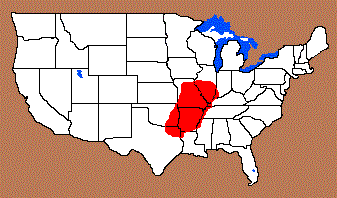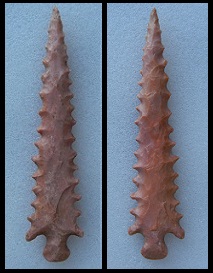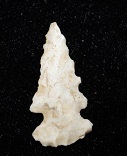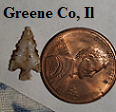Other Websites with Detailed Information:
Name Details:
Named By: James A. Brown
Named For:
Sequoyah, a Cherokee Native American scholar
Date Identified: 1968
Type Site: Spiro Site, Oklahoma
Sequoyah
Cluster: Scallorn Cluster
Commonly Utilized Material:
Date:
Cultural Period:
1,000 - 650 B.P.
Late Woodland to Early Mississippian
Medieval Warm
Caddoan / Cahokia Culture
Glacial Period:
Culture:
Outline is Representative of Size and Shape:
Description of Physical Characteristics and Flaking Pattern:
This is a
small thin triangular expanding stem point with a flattened cross section. The blade may vary from straight to slightly excurvate. The blade is narrow and commonly has course serrations. The shoulders may range from horizontal to barbed and are always well defined. The stem is narrow and elongated creating a wide notch. The stem is expanding. The base is convex and commonly
has a bulbous appearance which is the key identification of this point. This point has a random flaking pattern.
Size Measurements: Total Length - 20
to 45 mm, Stem Length - 5 to 9 mm (1/7 to 1/3 of the total length),
Blade Width - 9 to 21 mm, Neck Width - 4 to 6 mm,
Stem Width - 7 to 14 mm
Distribution:
Distribution Comments:
This point is primarily found in the Arkansas River valley in eastern Oklahoma and Arkansas
and throughout the Ozarks of Arkansas, Missouri, and Oklahoma.
This point is found Mid Mississippi River valley in Missouri and into Illinois.

Related / Associated Points:
Crisp Ovate
Additional Comments:
This was the most common point found at the Spiro site in Oklahoma (Justice, 1987).
This point is related to the Crisp Ovate (un-notched) point which is thought to have been the preform for the Scallorn and this point (Justice, 1987).
The Sequoyah point was originally classified as the Scallorn type (Bell, 1960). The difference was recognized at the Williams Shelter site in Missouri and was later formalized and named by James Brown in 1968.
Making the distinction between these two points may be difficult. The Sequoyah point is generally deeply serrated, have elongated blades, and a narrower hafting region with wider notches. (Justice, 1987).
Point Validity: Valid Type
Brown is a well-respected
anthropologist and professor at Northwestern University who has conducted extensive studies at the Spiro Mounds in Oklahoma. This type was named in a professional
publication and has limited professional references. This is considered a valid type.
.
Age Details:
References: (See Reference Page, Entry Number):
23, 30, 37, 179
Sequoyah Projectile Point, Sequoyah Arrowhead














